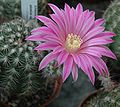Echinocereus adustus
| Echinocereus adustus | |
|---|---|

| |
| Scientific classification | |
| Kingdom: | Plantae |
| Clade: | Tracheophytes |
| Clade: | Angiosperms |
| Clade: | Eudicots |
| Order: | Caryophyllales |
| Family: | Cactaceae |
| Subfamily: | Cactoideae |
| Genus: | Echinocereus |
| Species: | E. adustus
|
| Binomial name | |
| Echinocereus adustus Engelm. 1848
| |
| Synonyms | |
| |
Echinocereus adustus is a species of cactus native to Mexico.
Description
[edit]Echinocereus adustus typically grows as a solitary cactus.[2] Its shoots are depressed spherical to short cylindrical, reaching up to 19 cm (7.5 in) long and 5 to 12 cm (2.0 to 4.7 in) in diameter, with fibrous roots.[2] It has 11 to 20 wavy, slightly tuberous ribs.[2] The cactus may have up to nine dark brown to blackish central spines, up to 3.2 cm long, with the top spine being very short and the bottom spines spreading horizontally.[2] It also has 8 to 31 white marginal spines with darker tips, up to 1.8 cm (0.71 in) long, with the radial spines being the longest.[2]
The short, funnel-shaped flowers are pink, appearing well below the shoot tips.[2] They are 3 to 10 cm (1.2 to 3.9 in) long and 4 to 7 cm (1.6 to 2.8 in) in diameter, with white or very light green scars.[2] The egg-shaped fruits are up to 2 cm (0.79 in) long with falling thorns, and when ripe, they are almost dry and split vertically.[2]
Subspecies
[edit]There are two recognized subspecies:[3]
Distribution
[edit]Echinocereus adustus is found growing in sandy loam in grasslands in the Mexican states of Chihuahua and Durango at altitudes between 1,800 to 2,400 m (5,900 to 7,900 ft).[4]
Taxonomy
[edit]The species was first described by George Engelmann in 1848.[5] The specific epithet "adustus" is Latin for "blackened" or "burnt," referring to the blackish spines of the cactus.[6]
References
[edit]- ^ Fitz Maurice, B.; Sotomayor, M.; Fitz Maurice, W.A.; Hernández, H.M.; Smith, M. (2017) [amended version of 2013 assessment]. "Echinocereus adustus". IUCN Red List of Threatened Species. 2017: e.T152470A121475913. doi:10.2305/IUCN.UK.2017-3.RLTS.T152470A121475913.en.
- ^ a b c d e f g h Anderson, Edward F.; Eggli, Urs (2005). Das grosse Kakteen-Lexikon (in German). Stuttgart (Hohenheim): Ulmer. p. 191-192. ISBN 3-8001-4573-1.
- ^ "Echinocereus adustus Engelm". Plants of the World Online. Royal Botanic Gardens, Kew. Retrieved 2024-06-29.
- ^ "Echinocereus adustus". LLIFLE. 2013-08-04. Retrieved 2024-06-29.
- ^ Wislizenus, F. A. (1848). Memoir of a tour to northern Mexico :connected with Col. Doniphan's expedition, in 1846 and 1847 /by A. Wislizenus. Washington: Tippin & Streeper, printers. doi:10.5962/bhl.title.41509.
- ^ Arts, American Academy of (1849). "Memoirs of the American Academy of Arts and Sciences". The Academy. ISSN 0096-6134. Retrieved 2024-06-29.
External links
[edit] Media related to Echinocereus adustus at Wikimedia Commons
Media related to Echinocereus adustus at Wikimedia Commons Data related to Echinocereus adustus at Wikispecies
Data related to Echinocereus adustus at Wikispecies



